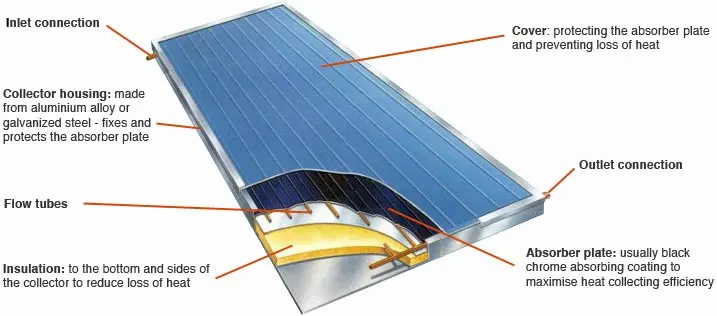SOLAR WATER HEATERS: Flat Plate vs Evacuated Tube; key components
- rentechsyst
- Jul 23, 2020
- 3 min read
Updated: Jul 20, 2024
The two most common types of domestic solar geysers are (i) Evacuated Tube and (ii) Flat Plate.
Flat plate collectors- made up of a collector surface that absorbs the solar radiation, a glazing to prevent the absorber from re-radiating the solar energy, a heat transfer medium (usually water or propylene), and insulation on the sides and back to prevent losses by conduction and convection [3]

Flat Plate Collector- Image Credit: Science Direct
Evacuated tube collectors- consist of a number of rows of parallel transparent glass tubes connected to a header pipe. Evacuated tube collectors do not heat the water directly within the tubes… air is removed or evacuated from the space between the two tubes, forming a vacuum. This vacuum acts as an insulator reducing any heat loss significantly to the surrounding atmosphere either through convection or radiation [4].

Evacuated Tube Collector- Image credit: Alternative Energy
How Flat Plate and Evacuated Tube Collectors compare?
(i) Evacuated Tube collectors, have low fluid residence time (time it takes fluid to travel through collector) and thicker insulation on all sides, lower convective heat losses, which results in less heat energy loss compared to flat plate collectors. This makes evacuated tube collectors suitable for cool climates…. and not so suitable for extremely hot climates (due to possibility of overheating). Zimbabwe’s climate is classified as “temperate”[2] so not extremely cold or hot, and any of the two types of collectors will do
(ii) Evacuated tube collectors’ water operating temperature range is between 60 degC to 120 degC; whilst for flat-plate it is between 60 degC to 80 degC
(iii) Flat plate collectors require a heat exchanger (indirect systems), whilst evacuated tube collectors don’t require heat exchanger
(iv) Maintenance: it is easy to replace the glass tube of an Evacuated tube collector.. whilst it is very difficult to replace the glass sheet of a flat plate collector
(v) Price: Flat Plate collectors are usually cheaper than evacuated tube collectors (by around 20%) though this can vary when comparing different manufacturers
Key System Installation Components
If a solar geyser installation is not done properly, it can be dangerous and hazardous. There are a few safety features and components that you need to look out for in your installation, which include the following:

(a) Temperature and Pressure Relief Valve- Sometimes the water in the tank can get over-heated, and this valve will ensure that there is “relief” in the tank
(b) Expansion Tank- because water expands when it heats up, most systems need an expansion tank (that small tank you see on top of the bigger tank on most systems). The expansion tank helps absorb the pressure increase created in the (closed) system when water is heated
(c) Air Vent Valve : in the solar collector loop, to prevent the piping from becoming air bound, thus eliminating un-wanted air in the water circulation loop [1]
(d) Vacuum Breaker/ Relief Valve - prevents back-siphonage (possibly contaminated water from the tank draining back into the house water line) of the geyser’s storage tank. Can also be replaced by a loop, that also prevents the back-siphonage
(e) Mounting: it goes without saying that the mounting of the tank and collector should be strong and secure to avoid the risk of falling off or through the roof. Best is to get a solar geyser set with mounting that has been tested and certified for different outdoor conditions.
Sources:
About Author:

Lovewell Chitiyo is a Mechanical Engineer with 15 years experience in the building services Engineering consultancy, renewable energy systems and sustainable design fields. He is currently studying Masters in Renewable Energy at Stellenbosch University in South Africa
Lovewell is an Accredited Professional with the Green Building Council of South Africa for Existing Buildings Performance and New Buildings; Interiors, holding several qualifications and certification in Renewable Energy and Sustainability.
Lovewell also has vast experience in design, supervision, installation and commissioning of several projects locally and regionally in the last 15 years.



Comments